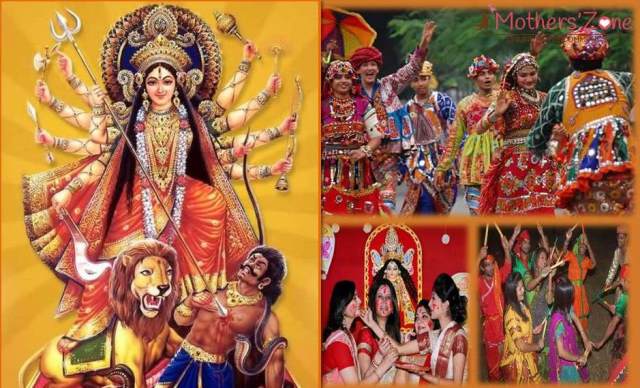Since my childhood days, Navratri celebrations have always attracted me and I have been waiting for the whole year to enjoy this special period when the sounds of “dhak” and the beautiful “Kaash phool” reminded me of the arrival of Goddess Durga. Navratri is a nine day and night celebration that is dedicated to Mother Goddess and includes fasts, meditation, prayers, strictly vegetarian diet and many more.

People all over India celebrate this festival with great enthusiasm and each state has their own rituals and customs. The pujas and vrats mark our tradition and symbolize the divine power of women. In this blog I will share with you how people of different states of India celebrate Navratri festival.
Gujarat
Navratri is a colorful festival of Gujarat and the devotees keep fast and worship Goddess Durga. It is more of a community event where people perform songs and dance popularly known as GarbaRaas and also perform jagran to please the Goddess. Women, children and men dance to the drumbeats with wooden sticks in their hands known as the Dandiya dance. Women place the Garba, which is the earthen pot with a lamp inside it that signifies the divine soul. Moving in circles around the Garba indicates the cycle of creation.
West Bengal, Assam and Bihar

Durga puja is one of the most important festivals of the people of West Bengal, Bihar and Assam and it is celebrated in the last four days of Navratri. The days are Saptami, Asthami, Navami and Dashami. People wear new clothes and worship large sized idols of Goddess Durga, Lord Ganesha, Kartikeya, Goddess Saraswati and Laxmi. They perform puja and seek blessings of success and prosperity. On the fourth day, the Bijoyadashami is celebrated when married women play with sindoor and apply it on the idol.
Delhi and UP

Navratri festival is also observed in Delhi and UP and here it is celebrated twice a year, once in the month of March-April and the second time during the month of September-October. People arrange for special dance programs known as Dandia and observe fast during this period. They follow a strictly vegetarian diet and eat food gains like kuttu, sabudana etc. On the 10th day known as Dashami, effigies of Ravana, Meghnath and Kumbhakaran are burnt in the Ramlila Maidan where hundreds of people gather to watch the event. This represents the victory of good over evil.
Kerala

The people of this state also perform puja in the evening of Asthami. It is considered to be a good time to start the formal education of children and the ninth day is dedicated to the worship of Goddess Saraswati. People go to temples where the children are introduced to the first alphabets and are made to write them on sand or rice. Dusshera is also celebrated there and the effigy of Ravana is burnt and crackers are burst to celebrate the victory of Lord Rama. Devotees visit the Saraswati temple at Kottayam and also visit the famous temples at Thekkegram.
Himachal Pradesh
People of this state offer prayers to Goddess Durga and visit various shrines in Una, Bilaspur and Kangra districts. Shri Bajreshwari Devi is a famous temple where thousands of devotees visit every year. The tenth day of Navratri is celebrated as “Kullu Dussehra” as the day of the return of Lord Rama after defeating the demon king Ravana.
Punjab

Navratri in Punjab is celebrated by observing fast for seven days and on the eighth day that is Asthami, the fast is ended by worshipping young girls who represent the Goddess herself. This celebration is known as “Kanjika”. They are offered puris and chanas and red chunnis. People also organize Jagran where they offer prayers and keep awake the whole night.
Maharashtra
People of Maharastra celebrate Navratri in the same manner as the people of Gujarat. Married women invite their relatives and friends and offer haldi and kumkum on their foreheads and gift them beetle leaves, beetle nuts and coconut. This is known as “Saumangalyam”. They also organize Garba and Dandia celebrations at night.
Karnataka

People of this state also celebrate the 9 nights of Navratri in the manner that dates back to the times of Raja Wodeyar in the 1610 and follows the trends of the great Vijayanagara dynasty. It is known as the “Naada Habba” and observes the victory of Goddess Durga over the demon Mahishasur. Exhibitions and fairs of artifacts and handicrafts are organized during this time.
Kerala
The people of this state also perform puja in the evening of Asthami. It is considered to be a good time to start the formal education of children and the ninth day is dedicated to the worship of Goddess Saraswati. People go to temples where the children are introduced to the first alphabets and are made to write them on sand or rice. Dusshera is also celebrated there and the effigy of Ravana is burnt and crackers are burst to celebrate the victory of Lord Rama. Devotees visit the Saraswati temple at Kottayam and also visit the famous temples at Thekkegram.
Tamil Nadu

Down to the South again, Navratri is celebrated in a different manner. Here they invite their friends and relatives to come and take a look at the Kolu, which is an exhibition of different types of dolls and figures. People arrange for competitions. They worship Goddesses Durga, Saraswati and Lakshmi and exchange gifts of clothes, sweets and coconuts.
Navratri is celebrated with great pomp all over India in various styles, though the main purpose remains same, which is to worship Goddess Durga in nine different forms.








































